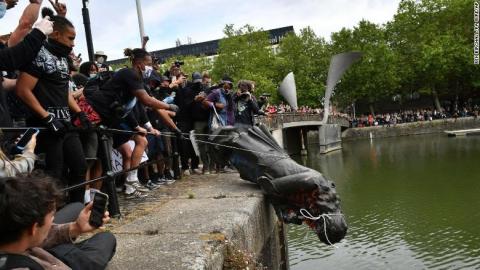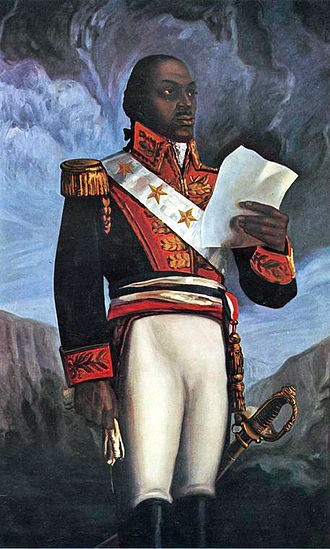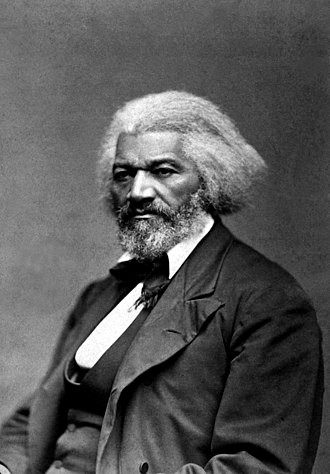You are here
Abolitionism must come from below: A critique of British Anti-Slavery Abolition

Source: Black Lives Matter Activists Throwing Statue of Edward Colston into river, June 2020
The political fall-out following the death of George Floyd, who died on the 25th May 2020 during a coercive physical restraint by a police officer in Minneapolis, USA and the revival of Black Lives Matter on a global level, has placed renewed emphasis on calls for defunding the state police and greater acknowledgement of the brutal British colonial past. These calls, alongside those for further recognition of the manner in which British wealth is in large part historically derived from the slave trade, have great significance for penal abolitionism (a moral philosophy which questions all forms of legal repression and dehumanisation). In the UK one of the main mobilising events of Black Lives Matter has been to call for the pulling down of statues and monuments which were erected to honour slave traders, such as the statue of seventeenth century slave trader Edward Colston in Bristol. Given this renewed emphasis on the British slave trade, should penal abolitionists today take inspiration from anti-slavery abolitionists in the late eighteenth and early nineteenth century and the broader political culture in Britain at that time? The short answer, I would argue, is NO. The bourgeois British liberal anti-slavery ‘abolitionism from above’ was not an emancipatory social movement like Black Lives Matter, nor did it connect with, or was motivated by, the experiences and voice of former slaves, as was sometimes the case in the USA anti-slavery movement during the mid-1800s. If we are looking for inspiration when challenging legal repression, dehumanisation and state coercion, then it is to the lived experiences and testimonies of slaves and former slaves, such as the American former slave Frederick Douglas, or Toussaint Louverture and all those slaves involved in the proclamation of the Republic of Haiti (Saint Domingue) from 1791-1804, that we will find genuinely radical and emancipatory social actors.
The politics of anti-slavery and English liberty
Whilst calls for the abolition of slavery had a long history – such as Jean Bodin in the 1570s or Antonio Vieira in the 1650s, in the main slavery was taken for granted in moral and political philosophy. Indeed, it was not until the writings of John Woolman and his fellow Quakers that there was an organised and principled critique of slavery in Britain. The British anti-slavery abolitionist movement that is most heralded today, however, emerged in the 1780s, and was underscored with ideas of free trade and free labour. For the British anti-slavery abolitionists ‘coerced labour‘ (i.e. slavery) was increasingly seen as less productive than ‘free labour’ (i.e. labour exchanged for money in the free market) and this was something that would become of increasing significance for capitalist accumulation across the British colonies at turn of the nineteenth century. Whilst these economic arguments proved wrong, they opened a space for a moral critique of chattel slavery.
Recognition that chattel slavery was a ‘social evil’ also gained moral and political significance following the defeat of the British in the American War of Independence in 1781. From the 1780s chattel slavery was increasingly considered as something which caste a moral stain on the British Empire. Whilst it was to take a number of decades for slavery to be fully denounced / abolished, the distancing from American slaveholders (rejecting their rejectors) as an ‘un-British’ state of affairs was of crucial importance. This was in part because it resulted in the promotion of a new moral basis for the empire through the very ‘English’ value of ‘liberty’’. In the late eighteenth century, the seeds of British Virtue and American Sin were sown and the critique of chattel slavery was the key symbolic index of this moral differentiation. For the British, it was not just military power than had failed them in the American war of independence, but also the moral foundations of their global leadership. Privileging English liberty and free market economics over slavery was one way of addressing this moral deficit. Indeed, ‘English liberty’ (and the moral condemnation of slavery) and free trade was considered as something that could justify further imperial expansion around the globe, especially Africa. In other words, anti-slavery advocacy provided a new form or ‘moral capital’ for the British Empire. Critiquing slavery and critiquing the British Empire, then, are not necessarily the same thing.
British anti-slavery abolition
For Quakers such as John Woolman, who was writing in the 1750s, chattel slavery should be morally condemned because was inconsistent with Christian morality and undermined the possibilities of a universal Christian brotherhood. Though providing strong moral and intellectual leadership, as well as being able to promulgate their ideas through the Quaker religious network, these and other early abolitionists were only moderately successful because they lacked access to political power. The ultimately more successful bourgeois British anti-slavery movement, mobilised across 50 years from 1788-1838, may well have drawn upon increasing grass roots support against the slave trade, but they also were part of the establishment. The British liberal anti-slavery abolitionists, such as Granville Sharp, Thomas Clarkson and William Wilberforce, all benefitted from either aristocratic patronage, wealth and/or had access to the political elite. It was these members of the British establishment who most strongly argued that chattel slavery stood against ‘English liberty’ and infringed upon basic British freedoms. Such anti-slavery also differentiated the British from the Americans and appeared to reinstate a sense of ‘moral superiority’ over their former colony. Yet, rather than being tied to emancipatory politics and praxis or calls for radical social transformation, the British anti-slavery abolitionists were reformers who were looking to strengthen the moral legitimacy of the current social, political and economic order. In so doing they worked closely with the British State to achieve their aims.
The intimate connections between anti-slavery abolition and the emerging capitalist state included then a clear moral discourse challenging the most barbarous social institutions of that time and showing moral leadership to the new (industrialised) working classes. The moral message was not just about the errors and vice of chattel slavery, but also about the importance of self-discipline, personal industry and engaging in what the anti-slavery abolitionists considered to be non-coercive labour – the capitalist labour market. This was in part because of growing (inaccurate) economic concerns among the ruling elite that the coerced labour of slavery was much less productive than ‘freely chosen’ labour of workers in the labour market and the increasing ideological influence of the free labour doctrines of political economists such as Francis Hutchenson. Chattel slavery was deliberately isolated from other forms of labour exploitation and presented as a unique and immoral aberration across the British Empire. The liberal, anti-slavery abolitionist ideology, highlighted the specificity of the misery of slavery, but in so doing deflected attention away from the inequities of the given social order, state racism and wider colonial abuses of power in the Empire.
It is important to note that the context of chattel slavery in Britain was different to the USA even before the defeat in the war of independence. In a 1772 legal case, which considered whether JamesSomerset could be treated as a slave on British shores, prominent abolitionist Granville Sharp successfully argued that as vlleinage – the then only legal form of feudal human bondage in Britain – had fallen out of usage in the early 1500s if not before, chattel slavery was against both natural and English common law. TheSomerset ruling was largely interpreted as meaning that chattel slavery was illegal in Britain, and whilst this was not actually the case, it did result in reinforcing popular mythologies of British freedom / English liberty as well as deterring many slaveholders from openly displaying their slaves in public or bringing new slaves into the country. Popular support against slavery was also augmented by the extensive evidence compiled by the British anti-slavery abolitionist Thomas Clarkson, who produced detailed accounts of the barbarous nature of the slave trade on his wider travels around the Empire. By 1789 William Wilberforce had initiated an anti-slavery abolitionist campaign in Parliament, and whilst this in the long term proved decisive, the French Revolution of the same year and the slave rebellion in the French colony of Haiti initially poured cold water on this idea. Yet the wheels of change had been irrevocably set in motion.
Ending chattel slavery but the unfreedom of free labour
By the 1830s chattel slavery had undoubtedly became the unacceptable face of labour exploitation, state racism and class domination in Britain and its empire. The Slave trade had been abolished in 1807 in Britain and the delayed introduction of the Slavery Abolition Act (1833) brought an end to slavery in British Empire in 1838. But during this this time, not only was there an intensification in the exploitation of ‘free labour’, but also a rise in penal servitude, which was to reach its zenith in Britain later that century with the ‘hard fare, hard bed and hard labour’ prison policies under the tenure of Edmund Frederick Du Cane. Indeed, there proved to be nothing inconsistent between the promotion of the liberal ideology of anti-slavery and associated adherence to “English liberty” and the creation of dehumanising ‘reformed prisons’ grounded in legal repression, nor the rampant domination and exploitation of labourers through free market capitalism.
The British anti-slavery abolitionist focus on a distinctly “British [English] freedom [liberty]” obscured the problem of ‘wage slavery’ and the appalling living and working conditions of people exercising their non-coerced ‘free labour’. Early socialist activists, including The Chartists, challenged anti-slavery meetings in Britain in the 1830s and 1840s, highlighting the close similarities between ‘wage slavery’ and ‘chattel slavery’. Indeed, this was no more certain than in the overtly ‘coerced’ labour of the ‘free market’, where, for example, English sailors were impressed into the navy; Scottish coal miners were forced to remain in this line of work for life; and until 1875 certain workers could be sent to prison for quitting their jobs under the Master and Servant Acts.
There are then clearly blurred boundaries between ‘coerced’ and ‘free’ labour. Market capitalist societies are inevitably underscored by some form of coercion, but this takes a number of different forms – slavery, imprisonment, contracted labour exploitation or starvation – for if people do not ‘freely work’ they will die. The differences between these forms of coercion are certainly important, and the nature and extent of coercion is clearly different between slavery and factory work for example, but still they operate on a continuum of coercion rather than as distinct entities. The beautiful idea of ‘freedom’ certainly is not well served in capitalist labour markets.
It is also worth remembering that there was no ending of penal servitude in the colonies of the British Empire post the ending of the slave trade. Prisons continue into the present and transportation to British colonies continued well past the end of chattel slavery. Further, the reformed prisons, since the early 1800s, have at various different times been places characterised by hard labour and are widely conceived in the critical penological literature as a state institution designed to discipline the labouring poor. They perform an important remainder of the coercive power of state and what awaits those who do not adhere to the requirements of ‘free labour’. Apparent contradictions in the language and commitment of liberty and freedom of the anti-slavery abolitionists may in fact simply just be a further indication of the fact that the capitalist free market is underscored by ever-present coercion. One of the leading ‘free labour’ advocates in the eighteenth century was the famous enlightenment thinker Francis Hutchenson. In his System of Moral Philosophy (Volume 2), published in 1755, he argued that “perpetual labour” may be “justly adjudged” as an appropriate punishment for law breakers. He goes on,
… no law could be more effectual to promote a general industry, and restrain sloth and idleness in the lower conditions, than making perpetual slavery of this sort the ordinary punishment of such idle vagrants, after proper admonitions and trials of temporary servitude, cannot be engaged to support themselves and their families by any useful labours. Slavery would also be a proper punishment for such as by intemperance or other vices ruined themselves and families, and made them public burden.
Finally, a number of British anti-slavery abolitionists, including leading campaigners like William Wilberforce, Samuel Romily and Thomas Fowell Buxton became prominent penal reformers. Indeed, William Wilberforce unsuccessfully acted as the advocate for Jeremy Bentham’s proposals for building a ‘Panopticon prison’ with the British Cabinet in the early 1800s. Penal abolitionism in Britain does not find its roots in the anti-slavery abolitionist movements of slavery, but perhaps penal reform does.
Four Things We Can Learn
The above critique of the British anti-slavery abolitionists may be helpful to us at this given moment for the following four reasons.
First, it indicates that a focus on the critique of slavery is not the same as shining a light on the brutal harms of colonial power and the British Empire. If the ending of slavery was a means of providing new moral capital for the expansion of the empire into Africa and elsewhere, then it is important that Black Lives Matter looks directly at the legacy and atrocities of the British Empire. This perhaps means a shift towards some of the harder symbols of the British Empire, including the historical and contemporary constitution of the British State.
Second, it indicates that anti-slavery abolition can be co-opted and utilised in the interests of the capitalist state and inform the moral discourse of the ruling elite more broadly. This shines an historical lens on the current moral capital that is accumulated through discourses of ‘modern slavery’. It is important to note that like its historical predecessors, modern slavery focusses neither on penal servitude or the exploitation of free labourers.
Third, for penal abolitionists, it is essential that connections are made across a wide range of sites of exploitation, repression and domination. The socialist critique of the anti-slavery movement in the 1830s and 1840s highlights the importance of exploring all forms of exploitation and close scrutiny of legal forms of coercion. Penal abolitionism must then consider together the historical legacies and contemporary manifestations of state racism; the insidious masculinist bias within the law and broader society; and the profound exploitation of capitalist labour relations.
Fourth, that engagement with the political, social and economic elite will not deliver social justice and radical social and economic transformation unless it is strongly tied / connected to the ‘view from below’ and infused with socialist emancipatory politics and praxis. What we can learn from the anti-slavery abolitionists is that when the ruling elite champion a given moral cause, it may well be for the ‘moral capital’ that can be transferred to them rather than an honest and noble intervention.
There are anti-slavery abolitionists that we can take inspiration from in the present, but these are the men and women who won their freedom through pain, personal struggle and triumph. It is the narrative of the slaves and former slaves that penal abolitionism should draw strength and it is their conceptualisation of freedom and liberty which should inspire abolitionists and anti-racist activists today.


